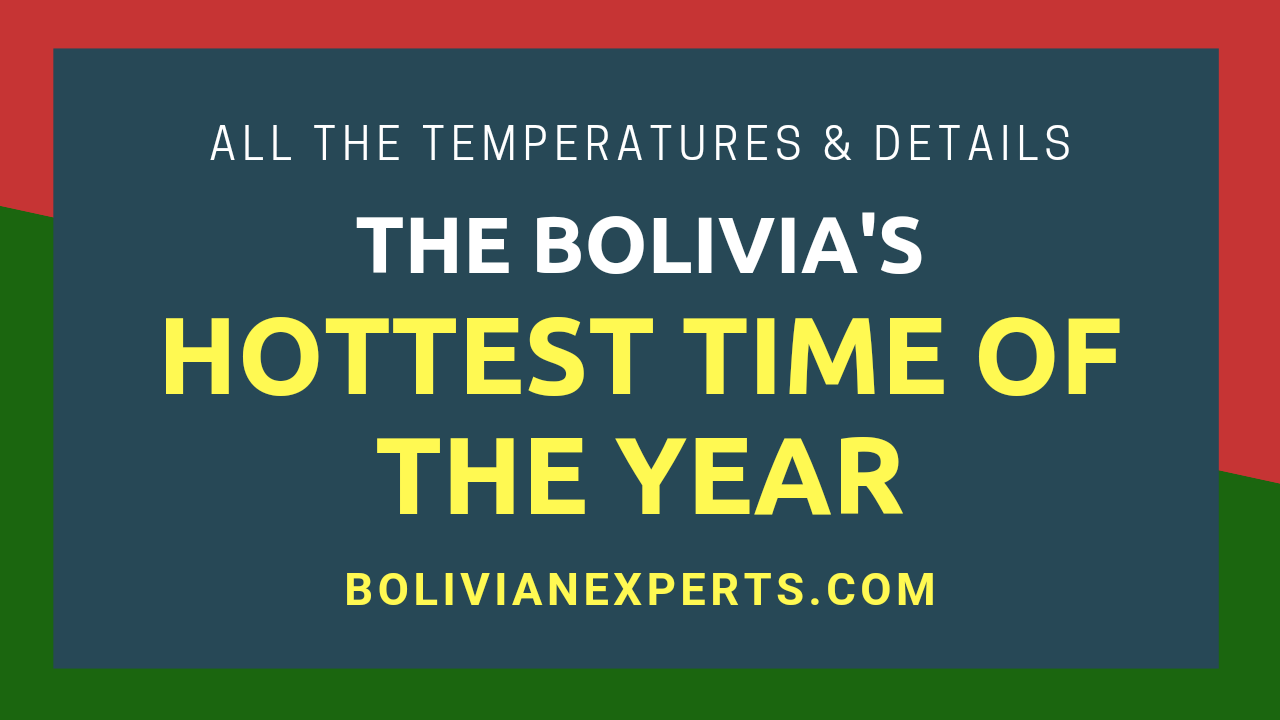Bolivia experiences its hottest season of the year at the same time all over the country. This period happens at the end of the year and it gets very hot, particularly in October, November, and December. Sometimes August and September can also be very hot, but how hot it really gets depends on the climatic region in which you are located.
The hottest time of the year in Bolivia always goes from October to December, and in some cases, it includes September and January. During this time, 66°F mean max and 74°F absolute max temperatures are normal in Altiplanic regions, 79°F and 89°F in tempered regions, and 89°F and 99° F in tropical regions.
Here, we will be talking about all the details involved in the temperatures and weather in the hottest time of our country, Bolivia. You’ll get all the accurate numbers and forecasted temperatures for this hot season in Bolivia, regarding different climatic regions, cities, and climatic seasons, among other details.
The hottest time of the year in Bolivia
Bolivia has the same behavior with its hottest time of the year in all the regions across the country. No matter if you are located in the west, east or central part of Bolivia, the hottest period will occur at the same time, more accurately at the end of the year, between October and December.
But the amount of heat you will experience within the country depends a lot on the climatic region in which you are. There are 3 distinct climatic regions in total:
- The Altiplanic West (Mean max temp: 66°F. Absolute max temp: 74°F from October to December). Generally very cold, reaching enjoyable weather during peak temperatures. The main cities located in this region are:
- La Paz
- El Alto
- Oruro
- Potosí
- The tempered Center (Mean max temp: 79°F. Absolute max temp: 89°F from October to December). With generally mild temperatures, but pretty hot in this season, still reaching comfortable weather during hot peaks). The main cities located in this region are:
- Cochabamba
- Sucre
- Tarija
- The tropical East (Mean max temp: 89°F. Absolute max temp: 99°F from October to December). Very warm, tropical, and Amazonian, reaching sometimes uncomfortable, too warm weather during hot peaks. The main cities located in this region are:
- Santa Cruz De La Sierra
- Trinidad
- Cobija
The hottest time in the 3 main Bolivian climates
As we just said before, Bolivia has 3 different main climatic regions, all of which differ a lot from each other when reaching the highest temperatures of the year. You can see all the numbers in the following table.
| (Mean max: / Abs max:) | August | September | October | November | December | January | February |
| Altiplanic cold West | 62°F / 69°F | 64°F / 73°F | 66°F / 75°F | 67°F / 76°F | 66°F / 72°F | 63°F / 73°F | 62°F / 71°F |
| Rugged tempered Center | 76°F / 88°F | 77°F / 91°F | 79°F / 94°F | 79°F / 87°F | 79°F / 85°F | 77°F / 85°F | 76°F / 86°F |
| Tropical hot East | 87°F / 98°F | 88°F / 99°F | 89°F / 100°F | 89°F / 99°F | 88°F / 97°F | 88°F / 96°F | 87°F / 95°F |
Source: https://senamhi.gob.bo/index.php/clima
| (Mean max: / Abs max:) | August | September | October | November | December | January | February |
| Altiplanic cold West | 17°C / 21°C | 18°C-/ 23°C | 19°C / 24°C | 19°C / 24°C | 19°C / 22°C | 17°C / 23°C | 17°C / 22°C |
| Rugged tempered Center | 24°C / 31°C | 25°C / 33°C | 26°C / 34°C | 26°C / 31°C | 26°C / 29°C | 25°C / 29°C | 24°C / 30°C |
| Tropical hot East | 31°C / 37°C | 31°C / 37°C | 32°C / 38°C | 32°C / 37°C | 31°C / 36°C | 31°C / 36°C | 31°C / 35°C |
Source: https://senamhi.gob.bo/index.php/clima
1) The altiplanic West
This is the coldest climatic region of Bolivia, as it’s located in the Altiplano, a vast, highly elevated flat land that normally has freezing temperatures during winter. Here it’s difficult to experience warm enough weather to wear light clothing or be comfortable at night.
But this situation certainly changes when this region goes through the hottest time of the year. During this period, as we said between October and December, you will feel warm enough to wear just a t-shirt or a shirt during the day and to still wear reasonably light clothing to feel comfortable at night.
The principal cities located in this region of Bolivia are:
- La Paz
- El Alto
- Oruro
- Potosí
In these cities, and all this region in general, you’ll feel just very comfortable during the day and will experience warm enough temperatures at night during the hottest time of the year.
That’s not the case when it’s winter or during the cold season, in which you’ll need to use tight clothing and will experience even freezing temperatures in many cases.
2) The hilly rugged Center
This central corridor crosses Bolivia from north to south and has been created by the Los Andes Mountain chain. This region is the transition between the very cold highly elevated Altiplanic west and the tropical low elevated east, so this is why this part of Bolivia is full of mountains, hills, valleys, and canyons everywhere.
Within 3 very large valleys of this region, 3 main cities of Bolivia are located, where the weather is generally mild even in the warmest period of the year.
The principal cities located in this region of Bolivia are:
- Cochabamba
- Sucre
- Tarija
During the hottest time of the year, this region and its cities experience quite warm temperatures, but still manageable and comfortable during the day, and there you’ll feel very fresh and warm enough at night.
Indeed, this is the region of Bolivia with the best climate for living in, because throughout the whole year, it’s normal to experience a very mild climate with not too much variation, not too hot nor too cold, and this doesn’t change a lot during the warmest period of the year.
3) The tropical West
As this is a vast tropical and Amazonian region of Bolivia (in fact, this is the largest part of the country) almost all year long the temperatures are very hot, and it gets even hotter during the hottest time of the year, between October and December, and sometimes also January in this area.
There, you’ll feel as if you were in a Caribbean country, and in the warmest period of the year, the temperatures sometimes will be quite difficult to manage and uncomfortable. During this time, people there will normally avoid too much sun exposure, and will at all costs try to stay hydrated.
Cambas (the so-called habitants of this part of the country) are very used to living in these warm temperatures, which can be on average about 100-105°F, with 90%-100% of humidity, in the hottest time of the year. But for a foreigner or a person not used to these temperatures, it’s quite difficult to feel good and do normal day-to-day activities.
The principal cities located in this region of Bolivia are:
- Santa Cruz
- Trinidad
- Cobija
During the warmest time of the year, of these three cities, Santa Cruz will be the coldest one, around just 2-3°F colder, but still reaching around 100°F during the day, and around 85°F at the coldest part of the night. Trinidad and Cobija will be a little bit warmer, reaching even 105°F during the day.
Something worth mentioning is that in this region of Bolivia, high temperatures are not accompanied by dry winds. Instead, you will feel very wet all the time, making it even more difficult to cool your body.
There is little risk of heatstroke in this region of Bolivia and its cities during the hottest time of the year (October and January). So, in general, be very careful with this possibility, as some days the temperatures there can even reach 110°F.
The really hot Gran Chaco region
Another fact you need to know is that in the tropical East of Bolivia, at the very South of the country, there is an area called The Gran Chaco region, in which, mostly from August to December, extremely high temperatures are experienced, reaching even 115°F in some cases.
This region is also where some of the highest historical temperatures in South America have been registered (116.6°F or 47°C, 2014).
No major Bolivian city is located in the Gran Chaco region, but there are several towns (Yacuiba, Puerto Suares, Villa Montes) and also some tourist places. Temperatures there during the hottest time come with very dry winds and weather in general. Be very careful of heatstroke and dehydration when being in this part of Bolivia.
If you want to know more about this place and all the towns and tourist locations that exist within it, visit our dedicated guide in the following direction: The hottest places of Bolivia, A complete overview.
The hottest time in the 10 principal cities of Bolivia
Now, we will see the monthly temperatures in the principal cities of the country during the hottest time of the year.
According to where they are located, some major cities are very close to each other in their average temperatures during the warmest period of the year, but they also differ a lot from other cities located in other climatic regions, as the table below shows.
| (Mean max: / Abs max:) | August | September | October | November | December | January | February |
| La Paz | 64°F / 74°F | 66°F / 77°F | 68°F / 79°F | 69°F / 78°F | 68°F / 74°F | 66°F / 79°F | 64°F / 72°F |
| El Alto | 58°F / 64°F | 59°F / 68°F | 59°F / 70°F | 61°F / 69°F | 60°F / 66°F | 57°F / 68°F | 57°F / 64°F |
| Cochabamba | 80°F / 87°F | 81°F / 90°F | 82°F / 97°F | 83°F / 90°F | 81°F / 88°F | 79°F / 88°F | 79°F / 86°F |
| Santa Cruz | 83°F / 95°F | 84°F / 97°F | 87°F / 98°F | 88°F / 97°F | 87°F / 97°F | 88°F / 97°F | 86°F / 96°F |
| Oruro | 63°F / 66°F | 65°F / 72°F | 68°F / 75°F | 70°F / 78°F | 68°F / 77°F | 65°F / 77°F | 65°F / 74°F |
| Potosí | 64°F / 72°F | 65°F / 75°F | 68°F / 77°F | 68°F / 77°F | 66°F / 72°F | 63°F / 68°F | 63°F / 72°F |
| Sucre | 72°F / 82°F | 73°F / 83°F | 75°F / 86°F | 74°F / 81°F | 73°F / 79°F | 72°F / 77°F | 70°F / 79°F |
| Tarija | 77°F / 95°F | 78°F / 99°F | 81°F / 99°F | 81°F / 91°F | 82°F / 88°F | 81°F / 91°F | 80°F / 92°F |
| Trinidad | 88°F / 98°F | 89°F / 99°F | 90°F / 100°F | 90°F / 100°F | 89°F / 97°F | 88°F / 95°F | 88°F / 94°F |
| Cobija | 90°F / 100°F | 90°F / 101°F | 91°F / 101°F | 88°F / 100°F | 87°F / 97°F | 88°F / 97°F | 88°F / 96°F |
Source: https://senamhi.gob.bo/index.php/clima
| (Mean max: / Abs max:) | August | September | October | November | December | January | February |
| La Paz | 18°C / 23°C | 19°C / 25°C | 20°C / 26°C | 21°C / 26°C | 20°C / 23°C | 19°C / 26°C | 18°C / 22°C |
| El Alto | 14°C / 18°C | 15°C / 20°C | 15°C / 21°C | 16°C / 21°C | 16°C / 19°C | 14°C / 20°C | 14°C / 18°C |
| Cochabamba | 27°C / 31°C | 27°C / 32°C | 28°C / 36°C | 28°C / 32°C | 27°C / 31°C | 26°C / 31°C | 26°C / 30°C |
| Santa Cruz | 28°C / 35°C | 29°C / 36°C | 31°C / 37°C | 31°C / 36°C | 31°C / 36°C | 31°C / 36°C | 30°C / 36°C |
| Oruro | 17°C / 19°C | 18°C / 22°C | 20°C / 23°C | 21°C / 26°C | 20°C / 25°C | 18°C / 25°C | 18°C / 23°C |
| Potosí | 18°C / 22°C | 18°C / 23°C | 20°C / 25°C | 20°C / 25°C | 19°C / 22°C | 17°C / 20°C | 17°C / 22°C |
| Sucre | 22°C / 28°C | 23°C / 28°C | 24°C / 30°C | 23°C / 27°C | 23°C / 26°C | 22°C / 25°C | 21°C / 26°C |
| Tarija | 25°C / 35°C | 26°C / 37°C | 27°C / 37°C | 27°C / 33°C | 28°C / 31°C | 27°C / 33°C | 27°C / 33°C |
| Trinidad | 31°C / 37°C | 32°C / 37°C | 32°C / 38°C | 32°C / 38°C | 32°C / 36°C | 31°C / 35°C | 31°C / 34°C |
| Cobija | 32°C / 38°C | 32°C / 38°C | 33°C / 38°C | 31°C / 38°C | 31°C / 36°C | 31°C / 36°C | 31°C / 36°C |
Fuente: https://senamhi.gob.bo/index.php/clima
La Paz, El Alto, Oruro, and Potosí
These 4 cities are located in the cold Altiplanic region of Bolivia (so-called Altiplano), so they share almost the same temperatures during the whole year, including in this hottest period.
As you can see, El Alto, Oruro, and Potosí cities behave almost equally during the hottest season, at the same time and with the same temperatures. But La Paz is a little bit warmer, anyway, not enough to be considered a tempered city.
What is normal to experience in La Paz during the warmest period of the year, between October and December, are warm enough temperatures to be outside with just a shirt and light pants or jeans during the day, and at night the temperatures aren’t too cold allowing you to feel good by just wearing normal clothing.
But in the other 3 cities, even in the hottest months, it’s necessary to use something else than just a shirt, thin pants or a jacket during the day, and at night you do need to still use thick clothing to feel comfortable and warm enough.
Cochabamba, Sucre, and Tarija
These 3 cities are located in 3 very large valleys within the rugged corridor that crosses Bolivia from north to south. These valleys have a moderate elevation, low enough to allow warmer mild temperatures.
As you can see in the table above, Sucre is a little bit colder the whole year. During the hottest time, it has warm temperatures to make you feel good during the day and fresh at night. Cochabamba and Tarija, are very close and the weather is almost the same,
In some cases or very few days, the temperatures in these cities can go up too much and make you feel as if you were in a tropical place, with too much heat making you feel comfortable, but it doesn’t happen too often and you rarely will experience very high temperatures in these cities.
In general, these 3 cities have the best, well-balanced, and tempered climate in Bolivia, and as we say before, this situation doesn’t change during the hottest time of the year. But instead, these cities carry other risks of getting endemic diseases, as you can read in this guide.
Santa Cruz, Trinidad, and Cobija
These 3 cities experience hot temperatures during the whole year. People living there are very used to this neverending hot weather. They normally don’t care about the always hot, humid, and in many cases rainy weather that usually is present there.
During the hottest period of the year, the temperature in these 3 cities goes even higher, in many cases it can go above the normal body temperature during the day. Also, at night, you’ll still feel hot there, but as we said, people, there are very used to it.
The table shows that Santa Cruz remains colder the whole year, but it still gets very warm temperatures in the hottest time, surpassing 103°F in many cases. The other 2 cities go even higher and some days you’ll feel there more than 105°F during the day, and not less than 90°F at night.
These 3 cities and this region experience very hot temperatures at the end of the year and they also generally reach 95% to 100% of humidity in the air, making it more difficult to cool your body. This situation has and can drive cases of severe dehydration and even heatstroke, so be very careful with this real possibility.
Whenever you are in these 3 cities and at this time of the year, between October and December, sometimes also September and January, if the weather becomes too hot, be highly focused on staying well hydrated and find a good shade to protect yourself.
The hottest seasons in the country
In Bolivia, in every corner and across the country, the hottest period of the year always occurs during the same seasons, which are:
- The whole spring (Always). It goes from 21st September to 20th December and is indeed the hottest season in Bolivia.
- At the end of winter (Usually). It goes from 21st June to 20th September. During September it becomes quite hot all over the country and some years this rising in temperatures can include August.
- At the beginning of summer (Usually). It goes from 21st December to 20th March. During January the temperatures across the country start to fall again, but in some cases, very high temperatures can last until February.
| Winter (July to September) | Spring (September 21st to December 20th) | Summer (January to March) | |||||
| (Mean max: / Abs max:) | August | September | October | November | December | January | February |
| Altiplanic cold West | 62°F / 69°F | 64°F / 73°F | 66°F / 75°F | 67°F / 76°F | 66°F / 72°F | 63°F / 73°F | 62°F / 71°F |
| Rugged tempered Center | 76°F / 88°F | 77°F / 91°F | 79°F / 94°F | 79°F / 87°F | 79°F / 85°F | 77°F / 85°F | 76°F / 86°F |
| Tropical hot East | 87°F / 98°F | 88°F / 99°F | 89°F / 100°F | 89°F / 99°F | 88°F / 97°F | 88°F / 96°F | 87°F / 95°F |
Source: https://senamhi.gob.bo/index.php/clima
| Winter (July to September) | Spring (September 21st to December 20th) | Summer (January to March) | |||||
| (Mean max: / Abs max:) | August | September | October | November | December | January | February |
| Altiplanic cold West | 17°C / 21°C | 18°C / 23°C | 19°C / 24°C | 19°C / 24°C | 19°C / 22°C | 17°C / 23°C | 17°C / 22°C |
| Rugged tempered Center | 24°C / 31°C | 25°C / 33°C | 26°C / 34°C | 26°C / 31°C | 26°C / 29°C | 25°C / 29°C | 24°C / 30°C |
| Tropical hot East | 31°C / 37°C | 31°C / 37°C | 32°C / 38°C | 32°C / 37°C | 31°C / 36°C | 31°C / 36°C | 31°C / 35°C |
Fuente: https://senamhi.gob.bo/index.php/clima
Spring is the hottest season in Bolivia
As you can see, the whole of spring in Bolivia is very hot, and indeed, summer in our country is not the hottest season, instead, it’s spring the season that carries this climatic feature.
Spring in Bolivia occurs at the end of the year. During this season, in cold cities like La Paz people start to behave as if they were in a tempered or even tropical city. But in tropical cities like Santa Cruz, tourists, and in many cases local people, start to feel very uncomfortable and too hot during this time.
Finally, in tempered cities like Cochabamba or Sucre, temperatures during this season remain acceptable, but there are other hidden health dangers like the Chagas disease, which we talk about in another note (see the link for more information).
Conclusions:
In this note about the hottest period of the year in Bolivia, you have seen that it actually occurs all over the country at the same time, always at the end of the year, between October and December, and in some cases, it includes September and/or January.
You also have seen that the heat you normally experience within the country in the hottest time of the year depends a lot on the climate region in which you are. If you are in a cold city or region like La Paz or the Altiplano, then this period will be warm enough to make you feel comfortable, with mean max temperatures of 66°F and absolute temperatures of 74°F.
Even more, if you are in a tempered region or city like Cochabamba, you’ll feel quite warm temperatures that rarely will make you feel uncomfortable, and most of the time you’ll feel just quite well with the level of heat, reaching mean max temperatures of 79°F and absolute temperatures of 89°F.
But if you are you’re in a tropical very hot city or region like Santa Cruz, you’ll feel in some cases overwhelmed by the amount of heat you will experience during the hottest time in the country, requiring you sometimes to stay very aware of your health status to avoid dehydration or heatstroke, reaching in these places mean max temperatures of 89°F and absolute temperatures of 99°F.
Finally, you’ve learned that the hottest season in Bolivia is spring, which happens from 21st September to 20th December, and in many cases, it also includes the end of winter and the beginning of fall. You also saw that there are some towns and tourist places in the Gran Chaco region that are really hot, sometimes reaching 115°F at the hottest time of the year.
We hope this information has helped you, and if you want to know every detail about the climate in Bolivia, including information about warm, but also cold places within the country, visit our definitive guide in the following direction: How is the climate in Bolivia? A full overview.
BolivianExperts.com, information about how to live, work, invest, and travel in Bolivia.








